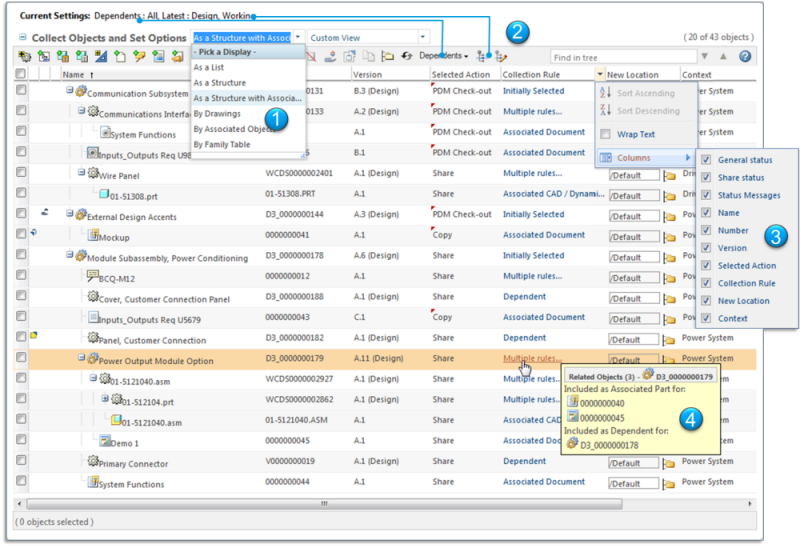Table View and Columns
The objects, information, and actions that initially appear in the Collect Objects and Set Options table vary depending on the following factors:
• Your individual user access and permissions.
• The type of the initially selected object.
• The action you are performing.
• The collector preferences for the action.
Use the table options to determine which objects are shared:

• Table View
Use the view drop-down menu above the table to change how objects are displayed. For example, you can view dependent objects as a structure below the initially selected object.
The default view is set using the > preferences in the Preference Management utility.
• Current Settings
The Current Settings status appears above the Collect Objects table with the following information:
◦ Dependents—Indicates whether dependent objects (child objects) are included in the table. Depending on the initially collected object type, possible values are All, Required, or None.
To change this setting, use the Dependents drop-down menu on the table toolbar.
◦ Filter settings—You can use a configuration specification to limit what appears in the table. Use the filter actions available on the table toolbar to manage this setting.
You can change the current settings using the following toolbar actions:
Icon | Action |
|---|---|
Return the table to its original state. When you reset the table, any related objects you have collected are removed and objects that you previously removed are returned. | |
View the filter settings currently applied to the table. | |
Edit the filter settings currently applied to the table. For more information, see Editing a Structure Filter. |
• Table Columns
The attribute columns in the Collect Objects table provide basic information about the selected objects.
Typically, multiple attribute columns are available in addition to those visible in the default table view. You can add and remove columns when you create a custom view. For more information about creating custom table views, hiding or adding columns, and setting column spacing, see Personalizing Tables and Table Views.
In addition to common attributes, the following information is available:
Column | Description | ||
|---|---|---|---|
General Status | A status indicator appears if the object is checked out to you or another user: • Checked out to you  • Checked out by another user  • Another iteration is checked out to another user  • Another iteration is checked out to you  | ||
Share Status | A status indicator appears if the object has been shared to another project: • Shared to a project  • Checked out to a project 
| ||
Status Messages | A status indicator appears to alert you about potential conflicts with the server: • Critical error  • Error  • Warning  • Information  Hover over the status indicator to view a message providing additional information. | ||
Version | The revision and iteration of the object. For more information, see Object Versions. | ||
Selected Action | The action to be taken on this object when you click OK. You can set this action using the toolbar action icons described below. | ||
Context | The PDM context of the object. | ||
PDM Location | The source PDM context of the object or the new PDM location for a project object.
| ||
New Location | Specifies the intended project and project folder for the object. Click the folder location icon
| ||
Collection Rule | Specifies the collection rule that applies to each object. For example, the objects you selected before launching the action are considered Initially Selected objects. Hover over the collection rule to view a message that provides information about additional object relationships. |
For more information on status indicators, see Object Status.
• Collection Rules
Collection rules determine which objects are automatically added to the Collect Objects and Set Options table.
You can customize the collection rules for each action type. For example, dependent objects might be automatically collected for the Add to Project action, but must be manually added when using the Send to PDM action.
Hover over the Collection Rule column to view additional information about object relationships. Objects that are not initially selected are either dependent or related:
◦ Dependent objects are objects that are included as lower-level objects in a structure.
◦ Related objects are objects that are not included in the structure but have been associated to the selected object.
To set these preferences, navigate to the Utilities page for the context, organization, or site and click Preference Management. Expand the Integral Operations preference group to set the initial collection rules for each action. For more information, see Configuring the Initial Collection of Objects for Actions.